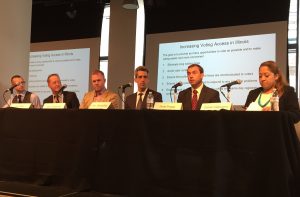Campaign looks to build democracy by increasing voter participation
By Jean Lotus Staff reporter — September 20, 2016
Illinois Campaign for Political Reform panelists Sept. 15 at Columbia College were (from left) Jerrick Adams of Ballotopedia; Jim Allen of Chicago of Board of Elections; John Opdyce of Open Primaries; State Sen. Daniel Biss; Cook County Clerk Director of Elections Noah Praetz; and Celina Villanueva of Illinois Coalition for Immigrant and Refugee Rights.
Motor-voter, mail-in ballots and same-day registration are great ways to lure Illinois residents into the electoral process, but steer clear of Internet voting, a panel of election experts agreed at the second Summit for Action & Civic Reform.
“Internet voting is inherently insecure,” said Noah Praetz, Director of Elections for Suburban Cook County. “We don’t want the Russians anywhere near an actual ballot.”
The not-for-profit non-partisan Illinois Campaign for Political Reform hosted a day-long series of discussions on voting access, Millennial engagement, campaign finance reform and social justice on Sept. 15 at Columbia College in Chicago.
Jim Allen, Chicago Board of Elections spokesman agreed that voter fraud was a danger with online voting.
“The danger is so extreme with internet transactions and elections because of the secret ballot,” Allen said. “If your bank account is hacked, [the bank knows] the amounts, they know the actors,” he added. “Once your secret ballot is cast you have to give up your ballot. The stakes are huge.”
Ruling out smart-phone voting, what are the best ways to get voter participation?
While Illinois turnout was around the U.S. average, Illinois is ranked 31st in the nation in turnout over the past four presidential elections, said moderator Susan Garrett, ICPR board chair and former state senator.
One problem: Many voters are turned off by declaring a party affiliation during the primary, said panelist John Opdycke, president of Open Primaries, an organization supporting the “independent voter” movement. Opdycke said 43 percent of American voters identified themselves as Independent. “People don’t fall into X and Y categories; it’s not that simple,” he said.
Panelist Jerrick Adams of Ballotopedia said California, Washington and Nebraska had increased voter turnout by changing to a “top two” system for primaries with an open ballot. Voters choose candidates on a mixed-party ballot and the top two vote-getters compete in the general election. One side effect of the top-two system is that more mainstream extreme candidates from either party reflect the values of the majority of voters.
This year, voters no longer had the excuse that they hadn’t got around to registering when Illinois introduced same-day voter registration in the spring primary. In Cook County, same-day registration brought in many younger voters, while early voting and mail-in voting helped older voters, David Orr’s office reported in April. The new same-day registration was patterned after the successful system in Wisconsin, panelists said.
Illinois ballots are complicated and too long, panelists agreed. Including judges and referendums there will be more than 80 voting options on the November ballot, they said.
“By the time you get down the ballot to community college board, it’s hard to make an educated choice,” said State Sen. Daniel Biss (D-Skokie).
Allen shared his memory of being chastised by President Barak Obama, visiting Chicago to cast a ballot in early voting. “He told me ‘16 screens with all these judges, [the election board has] gotta knock it off.’”
Biss said tweaks to the election process might move the number of participating voters a few points, but “the most important thing that moves turnout is voter interest. The voters feel the process doesn’t represent their interest, because of big money,” Biss said. He advocates campaign finance reform.
The bigger picture is not what percentage of registered voters cast ballots, Praetz said, but what percentage of total adults eligible to vote participate.
When the candidates on the ballot don’t look like the populations they represent, attracting immigrants and minority voters is tough, said Celina Villanueva, civic engagement manager from the Illinois Coalition for Immigrant and Refugee Rights. She advocated helping minority candidates get elected to small, local elections.
“It starts with changing the school boards, to have a say in terms of how are kids are being educated,” she said.
School boards as well as park district, library and local boards of trustees are usually not-partisan elected positions. Candidates usually don’t need a huge amount of money to run for these spots, she said.
Praetz, who oversees suburban Cook County elections, said every year in 130 villages about 65 percent of races were uncontested and there were often not enough candidates ran to fill out the boards.
Other ideas for boosting registration were discussed.
Gov. Bruce Rauner vetoed “automatic registration” legislation passed in May that would sign up anyone to vote when they interacted with state government, to renew a driver’s license, for example. The new rules were to go into effect in 2018 and would affect 750,000 voters, supporters said. Rauner said the administrative burden to prove that auto-voters were legally allowed to vote was too heavy. Supporters hope to overturn the governor’s veto before the New Year.
“Automatic registration flips the paradigm so the responsibility is on the government unless the voter chooses to opt out,” said Allen. Five states already enacted automatic voting, said Adams of Ballotopedia.
“Registration remains an artificial barrier,” Praetz said. “But we can fix that. We need a system that gives most people the most access where confidence levels [of vote security] are the highest.”
Returning civics education to the Illinois school curriculum should also help draw in younger voters, said Villaneuva. The ICPR helped draft and lobby for legislation to get civics back into schools. Just as long as no one insists on a smart-phone ballot.
Read the current issue of the Cook County Chronicle
Free subscription to the digital edition of the Cook County Chronicle
— Campaign looks to build democracy by increasing voter participation —







